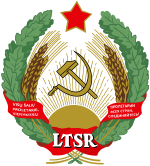Communist Party of Lithuania
| Communist Party of Lithuania | |
|---|---|

|
|
| founding | 1918 |
| resolution | 1991 |
| Headquarters | Vilnius |
| Alignment | Communism , Marxism-Leninism |
| Colours) | red |
| International connections | Communist International |
The Communist Party of Lithuania ( Lithuanian Lietuvos komunistų partija ) was the communist party in Lithuania . It was founded in early October 1918 .
history
The party operated illegally until 1940 . In summer this year, when the Red Army of the Soviet Union Lithuania forcibly occupied, the party was the Communist Party of the Soviet Union combined. At the same time, the Soviet rulers installed a new Soviet republic, the Lithuanian Soviet Socialist Republic , whose leading party, by definition, was the Communist Party of Lithuania. The party's first secretary at the time, Antanas Sniečkus , and the first secretaries that followed, thus became de facto governors of Soviet-occupied Lithuania. In the following 50 years of Soviet occupation of Lithuania, the party's first secretary from an ethnic point of view was always a Communist Lithuanian, and the second secretary was always a Russian posted directly from the CPSU party headquarters in Moscow.
When a movement to regain Lithuania's national independence, Sąjūdis , was founded in 1988 and this movement received the broadest support from the Lithuanian population, the Communist Party of Lithuania came under increasing pressure.
In February 1989, Sąjūdis publicly stated that Lithuania had been forcibly occupied and annexed by the Soviet Union in June 1940 and that the movement's long-term goal was to regain national independence. State independence was proclaimed by the movement in May 1989 - initially without any international recognition - and the conquest of Lithuania by the Soviet Union declared illegal.
On August 23, 1989 , the 50th anniversary of the signature of the Ribbentrop-Molotov Pact between the dictatorships of Nazi Germany and the Soviet Union , a 600-kilometer chain of two million people connected the cities of Tallinn , Riga and Vilnius and drew the attention of the international community Public on the aspirations of the inhabitants of the Baltic States . This demonstration and the coordinated efforts of the three Baltic nations became known as the Baltic Way ( Estonian Balti kett, Latvian Baltijas ceļš, Lithuanian Baltijos kelias).
On December 24, 1989, the Communist Party of Lithuania split. Some left the Communist Party of the Soviet Union (CPSU) and announced their consent to renounce the state monopoly of power. The other part founded their own organization which the CPSU continued to see connected. Mikhail Gorbachev called the split "illegal" the next day. In February 1990 representatives from Sąjūdis gained an absolute majority in the Supreme Council of the Lithuanian SSR . Vytautas Landsbergis was elected President of the Supreme Council. This prepared the state declaration of independence on March 11, 1990.
Democratic Party of Labor of Lithuania
In 1990, the Communist Party of Lithuania under the leadership of Algirdas Brazauskas was transformed into a new party under the name Lietuvos democinė darbo partija (LDDP, in German "Democratic Party of Labor of Lithuania"), which in turn later merged with the traditional, but united the small Social Democratic Party of Lithuania (Lietuvos socialdemokratų partija, LSDP) . The new united party kept the social democratic name, but is still mainly shaped by the ex-communist leaders.
Individual evidence
- ↑ a b December 24, 1989. Tagesschau (ARD) , December 24, 1989, accessed on December 29, 2016 .
- ↑ December 26, 1989. Tagesschau (ARD) , December 26, 1989, accessed on December 29, 2016 .
